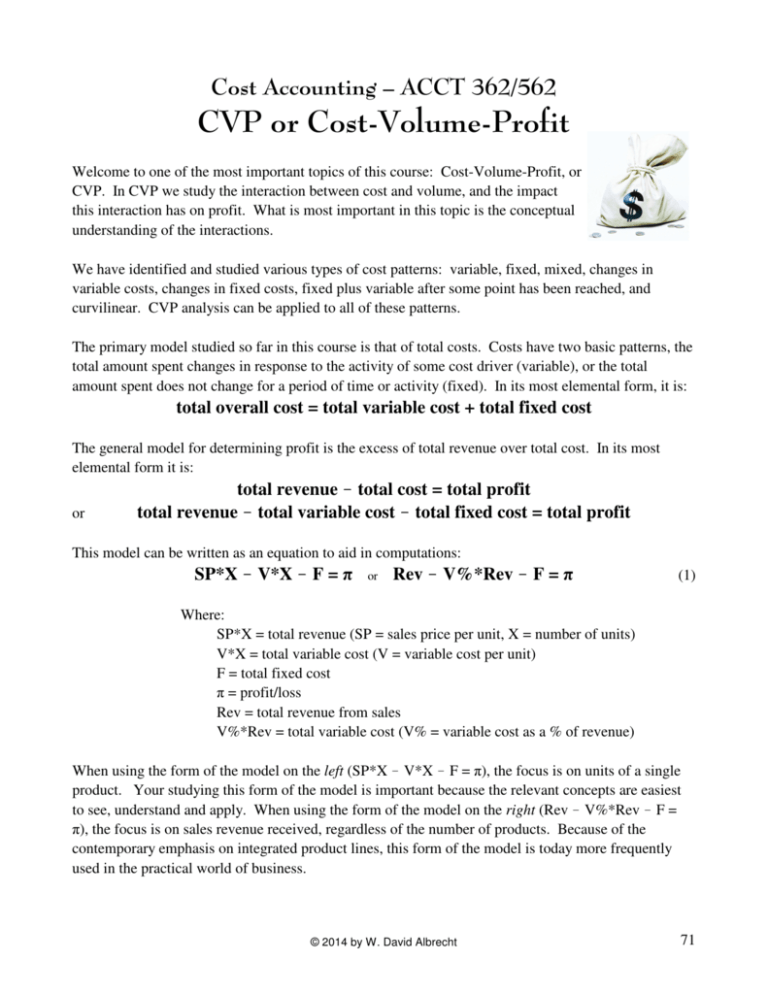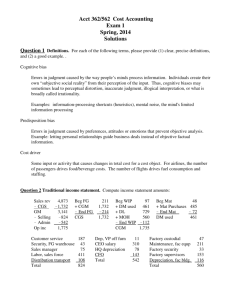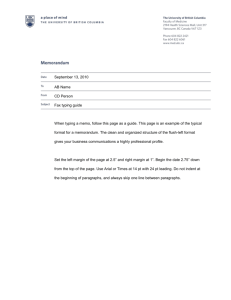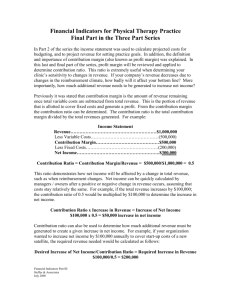CVP or Cost-Volume
advertisement

Cost Accounting – ACCT 362/562 CVP or Cost-Volume-Profit Welcome to one of the most important topics of this course: Cost-Volume-Profit, or CVP. In CVP we study the interaction between cost and volume, and the impact this interaction has on profit. What is most important in this topic is the conceptual understanding of the interactions. We have identified and studied various types of cost patterns: variable, fixed, mixed, changes in variable costs, changes in fixed costs, fixed plus variable after some point has been reached, and curvilinear. CVP analysis can be applied to all of these patterns. The primary model studied so far in this course is that of total costs. Costs have two basic patterns, the total amount spent changes in response to the activity of some cost driver (variable), or the total amount spent does not change for a period of time or activity (fixed). In its most elemental form, it is: total overall cost = total variable cost + total fixed cost The general model for determining profit is the excess of total revenue over total cost. In its most elemental form it is: or total revenue ! total cost = total profit total revenue ! total variable cost ! total fixed cost = total profit This model can be written as an equation to aid in computations: SP*X ! V*X ! F = π or Rev ! V%*Rev ! F = π (1) Where: SP*X = total revenue (SP = sales price per unit, X = number of units) V*X = total variable cost (V = variable cost per unit) F = total fixed cost π = profit/loss Rev = total revenue from sales V%*Rev = total variable cost (V% = variable cost as a % of revenue) When using the form of the model on the left (SP*X ! V*X ! F = π), the focus is on units of a single product. Your studying this form of the model is important because the relevant concepts are easiest to see, understand and apply. When using the form of the model on the right (Rev ! V%*Rev ! F = π), the focus is on sales revenue received, regardless of the number of products. Because of the contemporary emphasis on integrated product lines, this form of the model is today more frequently used in the practical world of business. © 2014 by W. David Albrecht 71 Summary: Model for single product: Model for product lines: SP*X ! V*X ! F = π Rev ! V%*Rev ! F = π From the Single Product Model to Useful Equations Let’s take a closer look at the variant of equation (1) for units of a single product SP*X ! V*X ! F = π (equation 1!units) The meaning of this equation is straight-forward. Profit is determined by subtracting total costs from total revenue. This seems so basic, but until the Italian merchant princes were able to identify this as the return on invested capital, it was not possible to form partnerships between unrelated individuals with capital. Only sole proprietorships and family partnerships were possible1. Factoring X units from each of the first two terms produces this equation: (SP ! V)*X ! F = π (equation 2!units) The excess of sales revenue over related variable costs is called the contribution margin. The contribution margin concept is explained or interpreted in this way. The revenues from sales (of product or service) are first used to pay for all the variable costs. The excess is used then to pay for fixed costs. Anything left over is profit. Reflect on the profundity of this meaning. Revenue first is applied to paying for the variable costs incurred in producing the revenue. There should be an excess, or else the company loses money for every additional item it buys/makes and sells. These contribution margins are accumulated until fixed costs are paid for. Past this point, contribution margins are all profit. Using CM as the abbreviation for the unit contribution margin, we get the most useful computational equations: CM*X ! F = π (equation 3!units) 1 An individual is focused on the creation and accumulation of wealth. A measurement of profit (or income) is necessary only for the parsing and allocation of wealth. © 2014 by W. David Albrecht 72 Shifting fixed cost from the left side to the right is significant: CM*X = F + π (equation 4!units) Why is this form of the equation so meaningful? The term on the left hand side accentuates that the total contribution margin is accumulated unit by unit. With only a few units, the total contribution margin is small. With many units, the total contribution margin is large. The terms on the right hand side show what is done with the accumulation. The accumulation is to pay for fixed cost. If the accumulation is insufficient to pay for the fixed cost, then π is negative and the company realizes a loss. If the accumulation is more than enough to pay for the fixed cost, then π is positive and the company realizes a profit. Dividing both sides of equation (4) by the unit contribution margin produces a very useful computational equation: (equation 5!units) The number of units X needed to be sold to pay for fixed costs and a desired profit is equal to the total contribution margin (F + π) divided by the unit contribution margin CM. A final useful equation results when comparing the amount of contribution margin at different levels of units. Creating an equation for two different levels of X such as X1 and X2, we get: CM*X1 ! F = π1 CM*X2 ! F = π2 Subtracting the second equation from the first, we get: CM*X1 ! CM*X2 = π1 ! π2 CM*(X1 ! X2) = π1 ! π2 CM*ª ªX = ªπ (equation 6!units) Because fixed costs do not increase or decrease with change in number of units, the change in units times the unit contribution margin is equal to the change in profit. © 2014 by W. David Albrecht 73 Six equations are a lot to study and remember. How do you narrow them down? Focus only on these two equations: CM*X ! F = π CM*ª ªX = ªπ A Long Example on the Basic Nature of CVP Keep in mind, the basic model for computing profit is: SP*X ! V*X ! F = π But for a lot of good reasons, we’re going to change the basic model to this: (SP ! V)*X ! F = π And the concept, again, is that on a per unit basis, we take the revenue for each unit sold, and use the first part of it to pay for the variable cost. The amount that is left is called the contribution margin. We try to sell sufficient units so that we accumulate enough contribution margins to pay off fixed cost. When fixed costs are exactly covered, we call this the break even point (profit equal to zero). Past the break even point, all unit contribution margins are profit. So, with experience, you’ll grow comfortable in thinking about the model as: CM*X ! F = π Here are the numbers for use in an example that should explain everything. The controller of ABC Company has determined the following estimates for a new product: Sales price per unit $100 Variable manufacturing cost per unit $35 Variable sales cost per unit $25 $60 Contribution margin per unit $40 Fixed manufacturing costs $200,000 Fixed sales costs $100,000 $300,000 © 2014 by W. David Albrecht 74 The questions commonly asked: 1. What is the break even point in units? This is important, because if we don’t think we can make enough units to break even, then we shouldn’t even make any plans to start the project, nor should we invest anything. 2. How many units must be produced/purchased and sold to make a profit of so many dollars? We are in business for a reason, after all. 3. How many units must be produced/purchased and sold to make a profit of a certain %? A rate of return is usually stated in terms of a percentage. 4. How much additional profit is generated if we produce 1, 10, 100 or X number of additional units? Likewise, How much additional profit will we lose if we produce 1, 10, 100 or X fewer units? (1) What is the break even point in units? Break even is where π =$0. From the numbers provided, the contribution margin per unit (CM) is $40, and the fixed costs are $300,000 in total. Plugging into our workhorse equation, we have: CM*X ! F = π ($40)*X ! $300,000 = $0 $40*X = $300,000 X = $300,000 ÷ $40 X = 7,500 units Generating an answer isn’t sufficient. There should always be an income statement proving the amount of profit, zero in this instance. Sales Revenue Variable costs Contribution margin Fixed cost Profit $750,000 – $450,000 $300,000 – $300,000 $0 7,500*100 7,500*60 7,500*40 at the BE point, π = 0 Calculating the number of units to reach a desired profit level, then preparing the income statement, are the two essential components of a good solution. Don’t go on until the organization and the computation of each number makes sense to you. © 2014 by W. David Albrecht 75 (2) How many units must be produced/purchased and sold to make a profit of so many dollars? In this example, let’s use a desired profit of $80,000. Plugging into our workhorse equation, we have: CM*X ! F = π ($40)*X ! $300,000 = $80,000 $40*X = $380,000 X = $380,000 ÷ $40 X = 9,500 units The income statement which proves 9,500 units produced/purchased and sold will generate $80,000 of profit is: Sales Revenue Variable costs Contribution margin Fixed cost Profit $950,000 $570,000 $380,000 $300,000 $80,000 9,500*100 9,500*60 9,500*40 the target profit An alternate view of this problem is very insightful. The equation we had just a few lines ago is: $40*X ! $300,000 = $80,000 Shifting fixed costs to the right side of the equation: $40*X = +$300,000 + $80,000 Now, dividing both sides by the contribution margin per unit: X = +$300,000/40 + $80,000/40 Or, X = 7,500 CMs for breakeven + 2,000 CMs for profit © 2014 by W. David Albrecht 76 (3) How many units must be produced/purchased and sold to make a profit of a certain %? In this example, let’s use a target profit of 10% of sales revenue. Total sales revenue is SP*X, or 100X in this situation. Plugging into the workhorse equation, we have: CM*X ! F = π ($40)*X ! $300,000 = 10% * ($100X) $40*X = $300,000 + $10*X $30*X = $300,000 X = $300,000 ÷ $30 X = 10,000 units The income statement which proves 10,000 units produced/purchased and sold generates profits of 10% is: Sales Revenue Variable costs Contribution margin Fixed cost Profit $1,000,000 $600,000 $400,000 $300,000 $100,000 10,000*100 10,000*60 10,000*40 profit of 10% of $1,000,000 sales No other answer is correct. (4) How much additional profit is generated if we produce X number of additional units? We’ve already established that the break even point (where profit = $0) is 7,500 units. Now, we’ll start by asking what would be the profit if we produced and sold one additional unit (or 7,501 in total)? The answer is $40. At 7,500 we have broken even and precisely covered out fixed costs. If we sell one additional unit (the 7,501st), the $100 revenue first goes to cover variable costs of $60, with $40 left over. Since the $40 is no longer needed to help pay for fixed costs, it is entirely profit. If we operate at 7,510 units, 10 above the breakeven point, our profit is $40 * 10 units = $400. We can think of this in terms of using the “change” equation. Going from 7,500 units (breakeven) to 7,510 units (new activity level) is a change in units of 10. Using the second workhorse equation of CM*ªX = ªπ, we get: CM*ªX = ªπ $40*(7,510 ! 7,500) = ªπ $40 * 10 = ªπ = $400. If we might operate at 10 units below the breakeven point, the amount of loss (remember, we are 10 contribution margins short of covering fixed costs) is $40 * (!10) = !400. © 2014 by W. David Albrecht 77 Deciding Between Two or More Cost Structures aka The Indifference Point aka The Crossover Point So far, we’ve operated with a basic assumption that operations must proceed with a given sales price and a specific amount of variable costs per unit and a certain amount of fixed costs. But this isn’t always the case. When first starting out, sometimes an entrepreneur has a choice between using a labor intensive approach or a capital intensive approach. A labor intensive approach has high variable costs per unit with a small investment in fixed costs. A capital intensive approach has low variable costs per unit with a larger investment in fixed costs, presumably for purchase of expensive information technology and automated equipment. Compared to a capital intensive approach, a labor intensive approach is frequently better at low output levels because only a small investment is needed to get going. If the product/project doesn’t catch on quickly, it can be discontinued with only a small loss. But at high output levels, a capital intensive approach is frequently preferred because it has low variable costs per unit and therefore a high contribution margin per unit. With a high number of units, the high contribution margin per unit provides conditions conducive to a very large profit. The decision making entrepreneur is very interested in the indifference point, where the capital intensive approach crosses over and becomes more profitable than the labor intensive approach. To find this point, place the profit equation of the labor intensive approach equal to the profit equation of the capital intensive approach and solve for X units. cm of labor * X ! F of labor = cm of capital * X ! F of capital For example, let’s say that a product with a selling price of $20 per unit can be produced with either a labor intensive approach or a capital intensive approach: Labor intensive V/unit = $16 F = $10,000 π = (20 ! 16) * X ! $10,000 Capital intensive V/unit = $6 F = $70,000 π = (20 ! 6) * X ! $70,000 The labor intensive approach is preferable at very low levels because of the much smaller amount of fixed costs. The labor intensive approach also has a lower breakeven point (2,500 units) than the capital intensive approach (5,000 units). However, at a very high level, say 100,000 units, the capital intensive approach profit of $1,330,000 (14*100,000 ! $70,000) is much greater than the labor intensive approach profit of $390,000 (4*100,000 ! $10,000) . © 2014 by W. David Albrecht 78 The indifference (crossover) point is computed by setting the profit equation of the labor intensive approach equal to the profit equation of the capital intensive approach. The following work shows how to compute the indifference point here, which is 6,000 units. cm of labor * X ! F of labor = cm of capital * X ! F of capital $4*X ! $10,000 = $14*X ! $70,000 $70,000 ! $10,000 = $14*X ! $4*X $60,000 = 10*X 6,000 units = X labor intensive < 6,000 < capital intensive The following income statements provide proof that at 6,000 units, the amount of profit under the labor intensive approach equals the amount of profit under the capital intensive approach. In this example, this amount of profit is $14,000. Labor Capital Sales revenue 120,000 20*6,000 120,000 20*6,000 Variable costs 96,000 16*6,000 36,000 6*6,000 Contribution margin 24,000 4*6,000 84,000 14*6,000 Fixed costs 10,000 70,000 π 14,000 14,000 © 2014 by W. David Albrecht 79 The preceding analytical process can be preformed in situations where there are three or more processes, each with a unique cost structure. An example to show this follows. Yidgets can be sold for $28 dollars each. Management has identified three processes. The cost structures for each process are: Process A: variable costs of $16 per unit and fixed costs of $140,000. Process B: variable costs of $20 per unit and fixed costs of $60,000. Process C: variable costs of $10 per unit and $400,000 fixed costs. The first step to computing the preferred process for various amounts of production and sales is to compute an indifference point between each pairing of two cost structures. In this example, it would be the indifference point between A and B, between A and C, and between B and C. The work for this step is: Comparing A to B: (28 ! 16)X ! 140,000 = (28 !20)X ! 60,000 4X = 80,000 Indifference point X = 20,000 B < 20,000 < A Comparing A to C: (28 ! 16)X ! 140,000 = (28 !10)X ! 400,000 6X = 260,000 Indifference point X = 43,333 A < 43,333 < C Comparing B to C: (28 !20)X ! 60,000 = (28 !10)X ! 400,000 10X = 340,000 Indifference point X = 34,000 B < 34,000 < C © 2014 by W. David Albrecht 80 The second step in the process is to identify which process is preferable between each indifference point. In this example, we’ll be computing the preferred process for 0 to 20,000 units (indifference point between A & B), for 20,000 to 34,000 units (the indifference point between B & C), for 34,000 to 43,333 units (the indifference point between A & C), and for 43,333 to infinity. The analysis follows: 0 to 20,000 B more profitable than A B more profitable than C A more profitable than C Therefore, B 20,000 to 34,000 A more profitable than B B more profitable than C A more profitable than C Therefore A 34,000 to 43,333 A more profitable than B A more profitable than C C more profitable than B Therefore A 43,333 to infinity A more profitable than B C more profitable than A C more profitable than B Therefore C In conclusion: B < 20,000 < A < 43,333 < C Putting it all together, B is the most profitable process for production and sales volumes below 20,000. However, it total production and sales activity will total between 20,000 and 43,333 units, then process A should be used to produce all units. It production and sales will be more than 43,333 units, then process C should be used to produce all units. © 2014 by W. David Albrecht 81 CVP When Costs Change You may recall the notes on a previous topic called “Cost Behavior.” The total cost equation is defined as: Total costs = V*X + F This equation assumes that the variable cost per unit is the same for all units of X. But this isn’t always the case. Variable costs per unit are sometimes high for a very low level of activity, then they drop due to volume discounts. At high levels of activity, they could increase again because resources become scarce. Actually, the patterns can vary quite a bit. Also, additional investments in fixed costs (step fixed costs) might be possible. In this section, we cover how to do CVP analysis when cost patterns change. We’ll use the following example to show how to perform the analysis. The Widget Company sells zidgets at $20 per unit. The cost structure is as follows. r There is an initial (fixed) investment of $200,000. r Variable costs for the first 12,000 units are $15 per unit. r After 12,000 units and up until 20,000 units, variable costs are $10 per unit. r Above 20,000 units, variable costs are $5 per unit. A question that might be asked is, “How many units must be sold to generate a before-tax profit of $45,000?” To solve this, first recall that the total contribution margin needed from the vantage of just starting production is: CM needed at start= 200,000 + 45,000 profit = $245,000 The first step is to compute how much contribution margin in total can be generated from the first 12,000 units. For these units, the contribution margin per unit is $5 = $20 ! 15. 12,000 units can generate a maximum total contribution margin of $60,000 (5 * 12,000). maximum CM from first 12,000 units = (20 ! 15)*12,000 = $60,000 This is less than the $245,000 of contribution margin originally set as the target. $60,000 is a good start toward reaching the target: CM yet needed = 245,000 ! 60,000 = $185,000 © 2014 by W. David Albrecht 82 For the next 8,000 units (12,001 to 20,000), variable costs are $10 per unit, so the cm/unit during this range is $10 = $20 ! $10. The maximum total contribution margin during this range of 8,000 units is: maximum CM from next 8,000 units = (20 ! 10)*8,000 = $80,000 This is less than the $185,000 of contribution margin still needed. CM needed after 20,000 units = 185,000 ! 80,000 = $105,000 We now need enough units at a $15 ($20 ! $5) cm/unit to pay for the remaining $105,000 of desired contribution margin. Units needed for CM of $105,000 = 105,000 / 15 = 7,000 Total units needed for desired profit = 27,000 = 12,000 + 8,000 + 7,000 Proof: R V CM F π 540,000 295,000 245,000 200,000 45,000 20*27,000 15*12,000 + 10*8,000 + 5* 7,000 © 2014 by W. David Albrecht 83 Focusing on Changing Units & Profit aka The Incremental Approach aka Complex CVP At the start of this chapter, I presented the very useful equation: CM*ª ªX = ªπ The usefulness of this equation stems from the incremental impact of a small change in activity. Often in business three related questions can be asked: 1. 2. 3. If we produced just a few units more, what would be the change in profit? If we wanted a specific amount of additional profit, how many units would we need to sell? Our competitor increased profit by X additional units and realized Y additional profit? What must be its cm/unit? The following examples show how to answer these questions. Example 1. The XYZ company produces and sells a single product with a CM of $10/unit. At 70,000 units, the XYZ company experiences a pre-tax loss of $10,000. It really desires a profit of $30,000. How many additional units must be produced and sold to generate a change in profit of $40,000? Also, what is the amount of fixed costs? CM*ªX = ªπ 10*ªX = 30,000 – (–10,000) 10*ªX = 30,000 + 10,000 10*ªX = 40,000 ªX = 40,000 / 10 ªX = 4,000 CM*X – F = π 10*70,000 – F = –10,000 700,000 + 10,000 = F 710,000 = F Proof: CM F π 740,000 –710,000 30,000 10*(70,000 + 4,000) © 2014 by W. David Albrecht 84 Example 2 The XYZ company produces and sells a single product with a CM of $85/unit. It has an opportunity to accept a special order of 680 additional units. How much additional profit results? CM*ªX = ªπ 85*680 = ªπ $57,800 = ªπ © 2014 by W. David Albrecht 85









